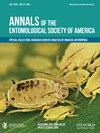Review of Spider Ecology During Carrion Decomposition, with a Field Study on Density and Taxa Richness in Pitfall Trap Captures of Geophilic Spiders (Aranea: Anyphaenidae, Corinnidae, Linyphiidae, Lycosidae, Salticidae)
IF 1.8
3区 农林科学
Q1 ENTOMOLOGY
引用次数: 0
Abstract
Abstract During a recent pig carrion succession study in northwest Florida, United States, we noticed an abundance of spiders but found that literature on spider ecology at carrion is sparse and scattered. We compiled a literature review of 569 carrion succession studies, of which 37 studies specifically mentioned the presence of spiders, with less than a third providing species-level identifications and only half providing family-level identifications. Nineteen spider families have been reported at carrion in the literature. Spiders are recognized as generalist, opportunistic predators in carrion succession studies, but only 38% of the studies that mentioned spiders during carrion succession included any ecological information. Data on spiders in the present experiment were compared to background samples, finding that the difference in abundance was statistically significant for all spider species combined. Seven species of spiders from five families were identified from both background and carrion succession samples; statistical differences in abundance were found for three species: the linyphiid Florinda coccinea and the lycosids Tigrosa annexa and Pirata seminolus. The family Corinnidae is reported from carrion for the first time. This research reviews the existing literature on spider ecology during carrion succession, provides additional data on species identity and abundance, and demonstrates the potential significance of spiders in carrion ecology and forensic investigations.腐肉分解过程中蜘蛛生态学的研究进展——兼论嗜地蜘蛛(蜘蛛目:斑蛛科、角蛛科、刺蛛科、刺蛛科、刺蛛科)的密度和分类丰富度
摘要最近在美国佛罗里达州西北部进行的一项猪腐肉演替研究中,我们注意到了大量的蜘蛛,但发现关于腐肉蜘蛛生态学的文献很少且零散。我们对569项腐肉演替研究进行了文献综述,其中37项研究特别提到了蜘蛛的存在,只有不到三分之一的研究提供了物种层面的鉴定,只有一半的研究提供家庭层面的鉴定。在文献中已经报道了19个蜘蛛家族在腐肉上。在腐肉演替研究中,蜘蛛被认为是多面手、机会性捕食者,但在提到腐肉演替过程中蜘蛛的研究中,只有38%包含任何生态信息。将本实验中的蜘蛛数据与背景样本进行比较,发现所有蜘蛛物种的丰度差异在统计上都很显著。从背景和腐肉序列样本中鉴定出来自五个科的七种蜘蛛;三个物种的丰度存在统计差异:linyphiid Florinda coccina和lycosid Tigrosa annea和Pirata seminolus。首次从腐尸中报道了科。这项研究回顾了现有关于腐肉演替过程中蜘蛛生态学的文献,提供了关于物种身份和丰度的额外数据,并证明了蜘蛛在腐肉生态学和法医学调查中的潜在意义。
本文章由计算机程序翻译,如有差异,请以英文原文为准。
求助全文
约1分钟内获得全文
求助全文
来源期刊
CiteScore
4.90
自引率
0.00%
发文量
25
审稿时长
6-12 weeks
期刊介绍:
The Annals of the Entomological Society of America exists to stimulate interdisciplinary dialogue across the entomological disciplines and to advance cooperative interaction among diverse groups of entomologists. It seeks to attract and publish cutting-edge research, reviews, collections of articles on a common topic of broad interest, and discussion of topics with national or international importance. We especially welcome articles covering developing areas of research, controversial issues or debate, and topics of importance to society. Manuscripts that are primarily reports of new species, methodology, pest management, or the biology of single species generally will be referred to other journals of the ESA. The most important criteria for acceptance are quality of work and breadth of interest to the readership.

 求助内容:
求助内容: 应助结果提醒方式:
应助结果提醒方式:


